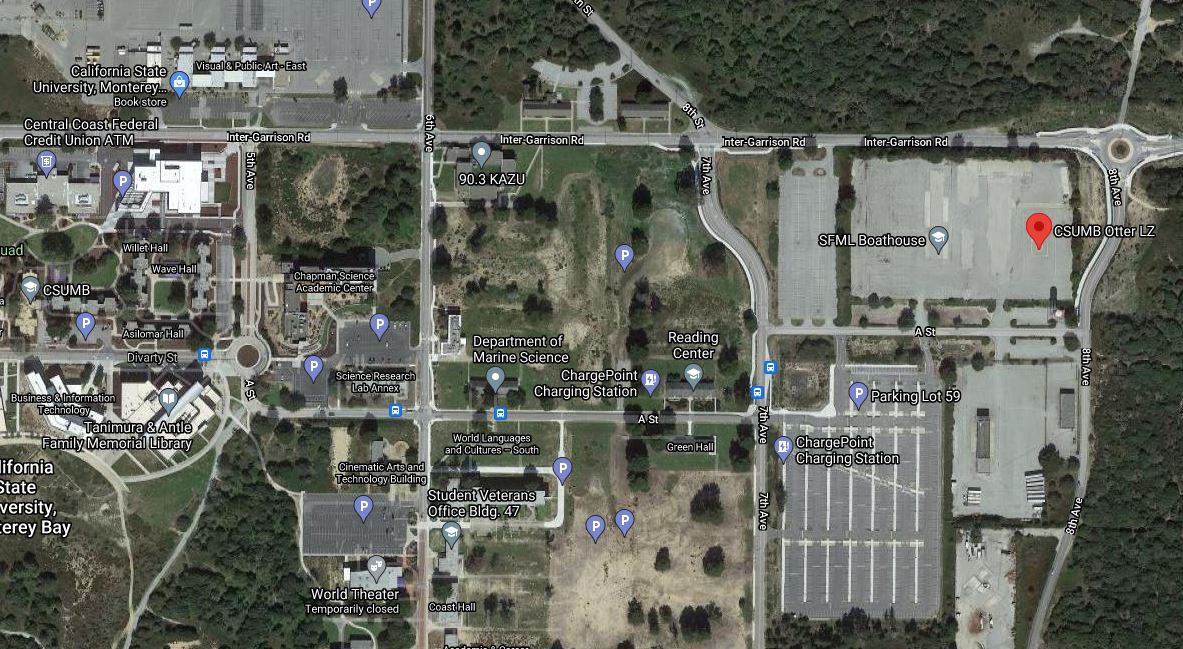Uncrewed Aerial Systems
CSUMB Uncrewed Aerial Systems (CSUMB UAS) FAQ
To fly on CSUMB property (including student/staff/faculty housing areas) you must be a certificated sUAS pilot under FAA Part 107 or hold a Section 333 or COA exemption, and have your flight request approved. CSUMB staff, faculty, and students should use the CSU Drones app to file a request, while outside entities should use the Flight Request Form for non-CSUMB operators. If your flight is within MRY controlled airspace, you will need to obtain clearance to fly via LAANC or another means as well. Recreational/hobbyist sUAS flights are not permitted at CSUMB.
If your flight is being conducted for any purpose associated with CSUMB (teaching, research, photography or videography for academic or promotional uses, etc.) then a flight request is required. CSUMB staff, faculty, and students should use the CSU Drones app to file a request, while outside entities should use the Flight Request Form for non-CSUMB operators. If your flight has no connection to CSUMB (other than that you are a CSUMB student, staff, or faculty member), no flight request is needed.
Yes, all flights on CSUMB property or conducted for CSUMB purposes off site require an approved flight request. Please file your request at least 5 full business days in advance.
If you are a non-CSUMB entity and do not have a CSUMB Proponent (this is uncommon), on the Flight Request Form please enter the proponent name (including email address) under "Proponent", choose "Other" under "Proponent Status", and list the Proponent's affiliation.
Yes, all flights on CSUMB property or conducted for CSUMB purposes off site require an approved flight request filed via the CSU Drones app. If your flight operations area is near any CSUMB residential facilities please file your request at least 5 full business days in advance.
The Otter LZ is CSUMB's dedicated sUAS Flight Operations Area. The approximately 50,000 square meter LZ is paved and free of obstructions, buildings, overhead powerlines, and other hazards. It is partially fenced, has only two entrance/exit points, and except when in use, no foot or vehicle traffic. This makes it particularly suitable for training, testing, demonstration, and other sUAS flight activities. High-precision, permanent Ground Control Points (GCPs) in the Otter LZ facilitate photogrammetrical calibration and accuracy assessment.
The Otter LZ is an FAA-Recognized Identification Area (FRIA), a defined geographic area where drones can be flown without Remote ID equipment.
As with all locations on CSUMB's campus, an authorized flight request is required in order to fly sUAS at the Otter LZ.
CSUMB staff, faculty, and students should use the CSU Drones app to file a request, while outside entities should use the Flight Request Form for non-CSUMB operators.
-
Flight requests should be filed at least 5 full business days in advance of the requested flight date. If your flight operations area is near any CSUMB residential facilities, or you are an outside entity and will be providing a Certificate of Insurance, file your request at least 7 full business days in advance.
- an email address where we can reach you
- Your Part 107 sUAS pilot certificate number and a copy of your certificate card
- The FAA registration number for your sUAS and a copy of the registration card
- Make and model and detailed sUAS specifications
- A flight plan, including latitude/longitude coordinates in decimal degrees, and a flight operations map
- Evidence of insurance if a non-CSUMB entity
Most of CSUMB's main campus lies within the Class C controlled airspace around the Monterey Regional Airport (KMRY). In addition to an approved CSUMB flight request, FAA authorization to fly in KMRY's Class C airspace is required. Depending on the proximity to KMRY, authorization to fly up to 300 or 400 feet AGL can be obtained electronically in near-real time via the Low Altitude Authorization and Notification Capability (LAANC); your flight request approval email will remind you of this.
- Conduct your flight(s) safely at the authorized location and time, or notify uassafety@csumb.edu if you cancel your flight(s).
- Obey all FAA Part 107 rules
- Report any safety incidents to uassafety@csumb.edu and the appropriate authorities immediately
- File a Post-Flight Report within 3 days using the form provided
LAANC is the Low Altitude Authorization and Notification Capability, a collaboration between FAA and Industry. It directly supports UAS integration into the airspace.
LAANC provides:
- Drone pilots with access to controlled airspace at or below 400 feet.
- Air Traffic Professionals with visibility into where and when drones are operating.
Through the UAS Data Exchange, the capability facilitates the sharing of airspace data between the FAA and companies approved by the FAA to provide LAANC services. The companies are known as UAS Service Suppliers – and the desktop applications and mobile apps to utilize the LAANC capability are provided by the UAS Service Suppliers (USS).
LAANC Resources
You can access LAANC via a variety of FAA Approved UAS Service Providers. A few examples are listed below:

